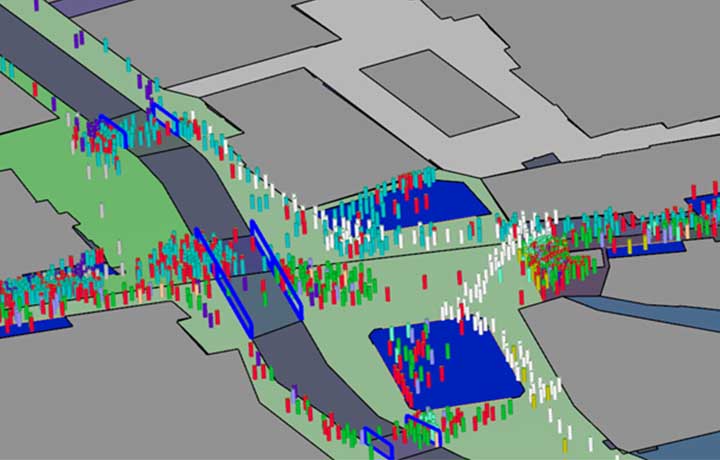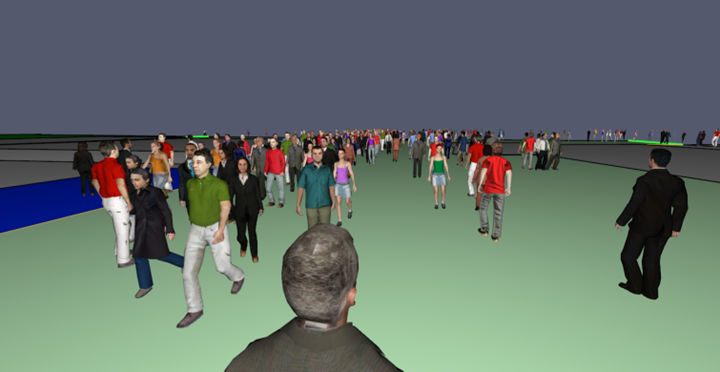
At LAVA Consultants, evacuation modelling is a vital component of our performance-based fire engineering services. Using advanced tools like Pathfinder, we simulate occupant movement and evaluate whether building layouts and egress provisions comply with safety objectives under fire scenarios. This article outlines the essential parameters that govern evacuation modelling and help ensure realistic, code-aligned results.
Pathfinder offers two main simulation modes—Steering Mode and SFPE Mode. Each modes are suited to different project types.
Steering Mode uses a physics-based approach where agents dynamically avoid obstacles and each other, offering a high level of behavioural realism. It is ideal for assembly occupancies, complex floorplans, or performance-based assessments. In contrast, SFPE Mode is based on empirical equations from the SFPE Handbook and assumes unidirectional flow along predefined paths. While suitable for simpler layouts or code-based checks, it lacks the behavioural flexibility of Steering Mode. For general building egress simulations and detailed crowd studies, Steering Mode is recommended to reflect natural human movement.
Walking speed is a fundamental input in evacuation modelling, directly influencing the total evacuation time. Pathfinder allows users to assign average walking speeds and statistical distributions based on occupant type. For the general population, a mean walking speed of 1.0 m/s is commonly used, while reduced mobility groups, such as the elderly or injured, are typically assigned a slower speed of around 0.6 m/s.
Using equations in the SFPE Handbook, walking speeds can be further refined using quantitative relationships based on population demographics and environmental conditions. Using realistic speed profiles ensures accurate estimation of Required Safe Egress Time (RSET).
Every agent in Pathfinder is defined by a body width, generally ranging from 0.45 to 0.6 metres. This attribute affects crowd density, flow rates, and congestion at doors, corridors, and stairwells. Narrower widths increase flow efficiency but may underrepresent realistic spacing. Accurate assignment of body widths is essential for modelling crowding, queuing, and bottlenecks, particularly in high-occupancy zones.
Exit width is a critical factor in determining evacuation flow rates. Simulations should always reflect actual door widths from architectural drawings, including any swing direction limitations or obstructions that may impede movement. Underestimating or omitting such constraints can lead to overly optimistic results.
The evacuation start time marks when occupants begin responding to the emergency. It is typically linked to the activation of the fire alarm or detection system, which can be synchronised with FDS outputs for integrated fire-egress analysis. Alternatively, fixed start times may be manually entered to reflect observed or assumed delays. This ensures the evacuation sequence aligns correctly with fire growth, smoke spread, and system responses.

The boundary layer represents the personal space that an agent maintains from others and surrounding walls. It prevents physical overlap between agents and significantly affects congestion dynamics in high-density areas. A boundary layer of 15 cm is typically adopted based on SFPE recommendations. Incorporating this buffer results in more realistic crowd interactions and reflects natural behavioural responses under stress, such as maintaining space in queues or while moving through confined exits.
Pre-movement time accounts for the delay between alarm activation and the moment occupants start moving. This includes time for perception, decision-making, and initial reactions. Pathfinder supports both fixed and distributed delays, such as normal or log-normal distributions based on building occupancy. For example, office occupants may have shorter delays, while sleeping or distracted individuals (e.g., in hotels or shopping malls) may take longer to react. Accurate pre-movement time definitions are essential for calculating RSET and comparing it against ASET.
As part of a comprehensive analysis, it is good practice to test evacuation performance under failure conditions. One common scenario is a blocked or inaccessible exit, caused by fire, smoke, structural damage, or crowd congestion. This sensitivity analysis helps assess system resilience and identify critical dependencies in the egress network. Simulating such scenarios is particularly important in large, complex, or assembly buildings where multiple exits may be required to ensure safe evacuation.
Evacuation modelling is not just about calculating exit times—it is about understanding how people behave in emergencies and ensuring that building layouts, exit provisions, and fire safety systems support safe and timely evacuation. At LAVA Consultants, we use Pathfinder to deliver realistic, data-driven evacuation models tailored to the occupancy type, population demographics, and architectural constraints of your project. Whether you’re designing a metro station, shopping mall, or commercial tower, our evacuation models support authority approval, optimise design layouts, and enhance occupant safety.
For expert evacuation modelling services contact jabir@lavaconsultants.com or visit our Evacuation Modelling Services page.
© 2025 Lava Consultants. All rights reserved